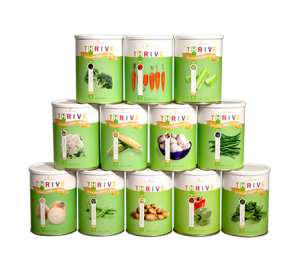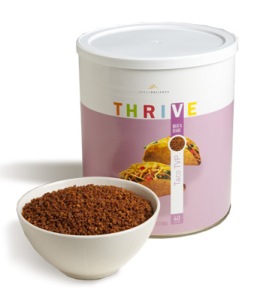 I’d like to take a moment to write a little bit about my personal feelings on the subjects of emergency preparedness, food storage and soup. I will explain the importance soup plays in this conversation in a little bit. First, I would like to explain my personal story of how I got into preparedness and what my motivations are to continue learning about this subject.
I’d like to take a moment to write a little bit about my personal feelings on the subjects of emergency preparedness, food storage and soup. I will explain the importance soup plays in this conversation in a little bit. First, I would like to explain my personal story of how I got into preparedness and what my motivations are to continue learning about this subject.
I think my interest in the subject began shortly after Hurricane Katrina. My personal observations alarmed me. What I saw were thousands of helpless people without any means of caring for themselves and their families, overburdened and overwhelmed safety and emergency departments and government assistance that was sluggish at its best. Now, where we live, we aren’t in any danger of hurricanes but it really made me sit down and think: If there was an emergency would I be able to sufficiently take care of my family’s needs without relying on anyone else? The answer was an alarming ‘no’.
I’m a mother of five children. As a mother, my job isn’t only to care for the basic daily needs of my children but also to plan for their future as best as I can with the resources I have. To me, this includes being able to care for them in the event of an emergency. Socially, it just makes good sense as well: if I am able to stay off roads and out of the way of emergency personnel, out of grocery stores, emergency rooms and doctor’s offices, I can leave those resources open for people who will really need them. Without getting into politics, it is apparent that our weather patterns are changing and that the weather these days is doing some funky fresh stuff and not in a good way. It seems unpredictable and we are seeing longer and stronger hurricane seasons, tornado and severe weather seasons, freezing winters (if this winter was any indication), hotter summers, droughts, etc. These things should not only alarm people to start educating themselves on what actions we might can take in this area but also to be prepared for the fact that it will more than likely continue.
So, that brings me around to my second point which is food storage. I have always been of the mindset that an ounce of prevention is worth a pound of cure. I think this applies to all areas of our life, not just our health. Putting food back just make good sense to me. Let’s put the subject of emergencies aside a moment. How many of us have either experienced a job loss, an illness that left us unable to return to work for a period of time, a death or know someone who has been affected by these things? In times like these, I can imagine what a relief it would be to know that because I prepared, my family’s basic needs could be covered for a time. Life happens and sometimes it gives very little warning. I look at it this way: The worst that could happen storing some food and supplies is that I wouldn’t have to visit the grocery store for a while (and if you hate going to the grocery store as much as I do, that thought makes you giddy).
And now, we get to the soup part. I LOVE cooking with my food storage ingredients. I think the best way to learn about them and fit them into your monthly budget is to make sure that you use them and use them often. I love coming up with new recipes and new ways of using the foods I store. But I am also a realist. I am not going to pretend that in an emergency situation I am going to be cooking up chicken Florentine or lasagna or such. My main concern is meeting my family’s nutritional requirements in the easiest way possible that maximizes the uses I can get out of my foods. And that, my friends, is where soup comes in.
Soup is great because you can just toss a bunch of stuff in there and make it edible. But to make a good soup, there is a bit of rhyme and reason to it. So first, you have to start with a base, usually chicken or beef stock. For our everyday purposes as well as food storage (because it lasts so long and is so easy to use) we keep on hand the Thrive chicken and beef bouillon bases. These are so great- they’re vegetarian based, they have a great flavor and I use them to not only create soups but to flavor rice and vegetable dishes as well. 1 teaspoon per cup of water is all it takes. They are great to put together cup of soup recipes for lunchtime at work or camping and backpacking as well. Meals in a jar are a snap to make with these.
 So, next comes the vegetables and you really want these to be the main part of your soups because they are going to give you needed vitamins, minerals and fiber. Freeze dried are great to work with and they re-hydrate right in the soup as it is cooking. The freeze drying process helps preserve many of the nutrients and minerals that are lost through canning and the basic process of entropy as food sits in the store. I feel like I give my family better quality of food and that I use less processed food when I keep freeze dried on the shelf all the time. And Thrive has some really great choices. My favorites are red and green peppers, sweet corn, green peas, chopped onions, diced carrots, green chilies, chopped spinach and celery. Another product that I LOVE for making beef based or chili type soups is the tomato powder. It add a good amount of vitamin C to your dishes and we use it for all types of foods including homemade Spanish rice (another easy meal in a jar dish to put together).
So, next comes the vegetables and you really want these to be the main part of your soups because they are going to give you needed vitamins, minerals and fiber. Freeze dried are great to work with and they re-hydrate right in the soup as it is cooking. The freeze drying process helps preserve many of the nutrients and minerals that are lost through canning and the basic process of entropy as food sits in the store. I feel like I give my family better quality of food and that I use less processed food when I keep freeze dried on the shelf all the time. And Thrive has some really great choices. My favorites are red and green peppers, sweet corn, green peas, chopped onions, diced carrots, green chilies, chopped spinach and celery. Another product that I LOVE for making beef based or chili type soups is the tomato powder. It add a good amount of vitamin C to your dishes and we use it for all types of foods including homemade Spanish rice (another easy meal in a jar dish to put together).
So now that we have talked about bases and veggies, we’ll move on to proteins. For emergency storage, you really cannot beat the price and quality of TVP (textured vegetable protein). This is the same thing used in the veggie burgers and meat substitutes you find at the store, only they last a whole lot longer because they are freeze dried. There are opinions for and against using TVP and soy products and I won’t get into them here because when we are talking about emergencies, I really don’t think any of us are going to sit around debating the pros and cons of a protein source. Vegetarians have been using soy for a LONG time as a meat replacement and they are some of the healthiest people on the planet. I really like the chicken TVP– I can put it in chicken noodle soup and no one really notices the difference. I LOVE the taco TVP not only because of the texture but the flavor as well. It’s great for taco dishes and burritos but also to toss into chili as a quick protein source. Beans are another staple and the great thing about the instant beans Thrive sells is that they can cook up in about 20 minutes in a soup or stew without soaking or simmering for hours. I can literally grab a handful, toss them in and we’re good to go.
great for taco dishes and burritos but also to toss into chili as a quick protein source. Beans are another staple and the great thing about the instant beans Thrive sells is that they can cook up in about 20 minutes in a soup or stew without soaking or simmering for hours. I can literally grab a handful, toss them in and we’re good to go.
We also need to throw in a word about grains here because there are several that have very good sources of proteins, especially when combined with legumes. My go to for storage would be quinoa. I choose this because it is a food that contains all the essential amino acids in it that the body cannot manufacture itself. I would call it a superfood and it has been used since ancient times. Quinoa technically isn’t a grain- it is a seed-  but whatever. It’s great- rinse and toss some in every soup, stew and chili you make and don’t miss out on giving your family its incredible nutrition. Another good one to store of course is rice- especially brown rice which when combined with a food such as lentils, provides a complete protein source as well. Rice can be tossed easily into soups. Barley is another great choice to keep on hand (now you can see where I’m going with this soup thing).
but whatever. It’s great- rinse and toss some in every soup, stew and chili you make and don’t miss out on giving your family its incredible nutrition. Another good one to store of course is rice- especially brown rice which when combined with a food such as lentils, provides a complete protein source as well. Rice can be tossed easily into soups. Barley is another great choice to keep on hand (now you can see where I’m going with this soup thing).
So, whenever someone on a budget ( like most of us) has a question on how to get started with storing food when there is so much out there to choose from my answer is ‘start with the soup’. Make a list of the ingredients you need to make several quick soups and begin stocking those first and then add on more selections as those stocks build up. We get to our destination by taking one small step at a time. Planning is key. And USE your foods. Cook with them, see how easy they are to use and prepare healthy, nutritious meals for your family every day in about the time it would take you to drive down to the fast food restaurant and stand in line for a burger and fries.